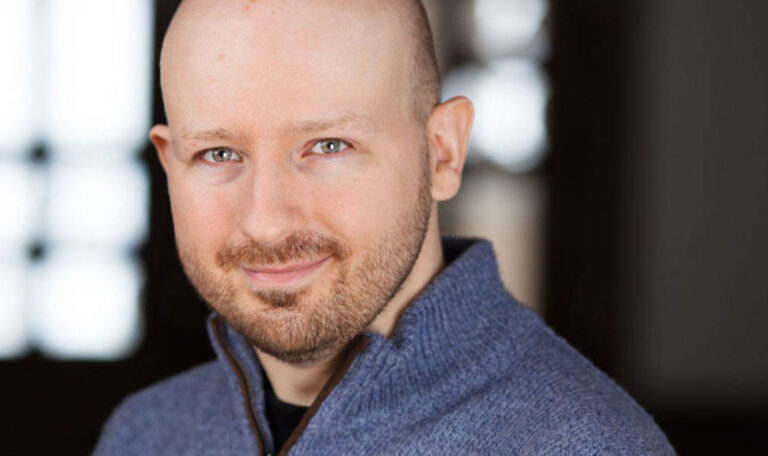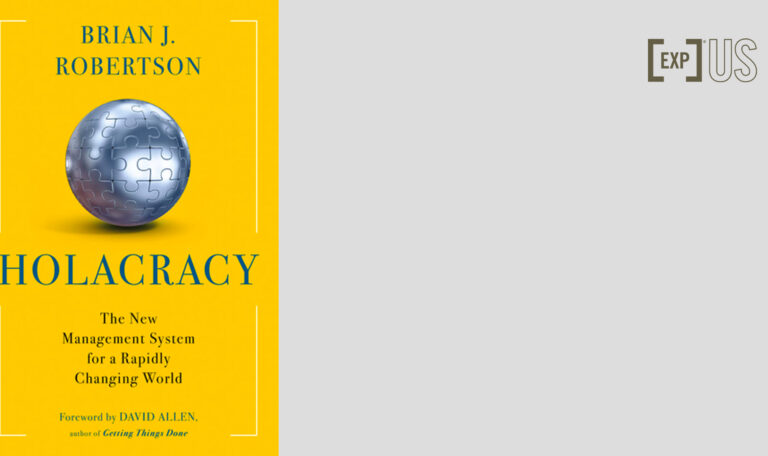Central Ideas:
1- In holacracy, the distribution of authority is not just taking power away from one leader and assigning it to someone else. The throne of power is no longer one person at the top of the hierarchy but is part of a process defined in a written constitution.
In the two spheres covered by holacracy – governance and operations – the first begins since the operations of all organizations are based on the structure built by governance.
3- The facilitator’s role in meetings is similar to that of a referee on a sports field: you serve the game, not the players. When you eliminate deviant behavior, it is not because you are angry with the person, just as the referee is with the player caught in a foul.
Adopting holacracy with all parties is a must, but it is possible to exercise it all in one part of the company. It is not uncommon to see one department or area serve as a pilot for the adoption of holacracy, before the organization implements it as a whole.
The intuition that one is approaching the limit of one’s individual capacity is what first inspires a leader to seek a new organizational practice to enable the business to gain in scale. That practice is holacracy.
ABOUT THE AUTHOR:

Brian J. Robertson created the concept of holacracy. He founded HolacracyOne to train companies in the new process. Robertson previously founded a software company, where he tested the principles of holacracy. Hundreds of companies worldwide have been trained by him and his company in the new management concept.
Part 1 – Evolution in action: What is holacracy
Just like an airplane, every company is equipped with sensors – not lights and indicators, but human beings playing their roles and perceiving the reality around them. Often, a “sensor” in the organization gives essential information that is ignored and remains unprocessed. One person perceives something important, but no one else sees the problem. Moreover, there are no channels available to transform this perception into a meaningful change. Therefore, we always ignore the “low voltage” lights in our organizations.
Where there are diverse people, there are multiple perspectives. Therefore, in most teams, critical views that are not shared by the leader or the majority are often ignored or discarded. Even when we want to do things differently, we have no way of integrating all the different perceptions, and so we end up aligning ourselves with the leader or the majority. We ignore the person who may have essential information because we need to stay the course or move on.
Instead of continually evolving in response to real tensions felt by real people, the model of organizations that adopt the prediction and control approach prioritizes the prior structuring of a ‘perfect’ system to prevent tensions (and then prioritizes reorganization once the leaders in the hierarchy realize they have not achieved perfection).
After years of experimentation, says Brian Robertson, going through several organizations, a new, comprehensive operating system has emerged as a result of my efforts and those of others. We call it holocracy. What is holacracy? Essentially, it is a social technology for governing and operating an organization, defined by a set of rules quite different from those used to conventionally run a company. Holacracy includes the following elements:
- A constitution, which establishes the “rules of the game” and redistributes authority;
- A new way of structuring the organization and defining the role of people and their internal spheres of authority;
- A unique decision-making process to update rules and authority;
- A meeting process to keep teams in sync and get the job done together.
- Distributed Authority
There is a difference between the bureaucratic organization of a company and the self-organization of individuals in a city. In the urban environment, people share space and resources locally, accepting territorial boundaries and responsibilities. Sure, there are laws and public agencies that define and enforce this legislation, but people don’t have bosses dictating to them all the time. If the residents of our cities had to wait for authorization from a boss to make every decision, the city would soon collapse. In our companies, however, a very different organizational principle is at work.
Heavy reliance on the CEO or his equivalent limits the use of perceived tensions in the organization as a whole and creates a potential single point of failure in the company’s ability to govern itself effectively. As business writer Gary Hamel states, “Give someone the authority of a king and sooner or later there will be real confusion.” Hamel further notes that, more often than not, “the most powerful managers are the most removed from the reality of the front line. Too often, the decisions they make high up on Olympus prove impractical on the ground.”
In holacracy, the distribution of authority is not just a matter of taking power out of one leader’s hands and assigning it to someone else or even a group. Instead, the throne of power ceases to be by one person at the top of the hierarchy and becomes part of the process, defined in detail in a written constitution. The holacracy constitution is a generic document that applies to any organization that wishes to use the method. Once it is formally adopted, the constitution becomes the company’s law book. Its rules and processes reign supreme, trumping even the person who adopted the constitution. Just like a Congress that defines laws based on the constitution. By heroically ceding his authority to the method he has adopted, the leader paves the way for an authentic distribution of power at all levels of the organization.
“When this change occurred in the companies I worked with, it was like a revelation and a challenge for everyone involved. The workers realized that they were no longer just employees following orders. They actually had power and authority – and, consequently, responsibility. They also no longer relied on a paternal boss to solve problems.
Governance refers to the way we structure the company and its functions to best express its purpose in the world. Operations are the use of that structure to realize that purpose in the world. The main goal of holacracy is to enable the organization to best express its purpose. In this sense, and in many others, holacracy is not a process of governance “of the people, by the people, and for the people,” but is the governance of the organization, through the people, for its purpose.
- Organizational Structure
In an organization energized by holacracy , people actually refer regularly to their own and others’ job descriptions – sometimes daily – because that document contains relevant, accurate, clear, and useful information about what makes sense to accomplish and what to expect from whom. This means that the way we actually work together (the existing structure) more faithfully reflects what is documented (formal structure) and is closer to what would be best for the company (necessary structure). Therefore, the three structures become one and the same, at least for a period, until another tension is perceived and this evolutionary process continues.
The structure applied by holacracy in organizations is not the traditional hierarchy, but a “holarchy,” a term coined by Arthur Koestler in his 1967 book The Phantom of the Machine. In this work, he defines “hólon” as “a whole that is part of a greater whole” and “holarchy” as the “connection between holons”. These words may sound strange, but they describe something very familiar. Our own body is an example of a holarchy. Each cell is a holon, a whole in itself and part of a larger whole, an organ. In the same way, each organ forms a whole and integrates a greater whole, our body. This integrated series of holons – cell, organ, organism – is an example of holarchy.
When we reflect on a company through the prism of hólons and holarchies, we may assume that human beings are the smallest hólons in the organizational system, surrounded by larger hólons made up of teams, departments, and so on. But human beings are not “complete parts of an enterprise,” like cells in relation to an organ. Instead, we are autonomous, separate entities that choose to attend to “power” the functions of a company, which is structured into various “roles.”
The focus of the holarchy is on clearly differentiating individuals and the roles they play. The structure of the organization is defined by the roles it needs to pursue its purpose, without reference to specific people in the company. They come later, to energize those roles. Once we have defined the roles that the company needs to go after its purpose, we can consider the available talent and assign them to the roles best suited to their profile. Most of us can occupy multiple roles naturally.
The purpose tells us why the role exists, what it aims to accomplish. The domain (there may be several) specifies what that role has the sole authority to control on behalf of the organization, in other words, it is the “ownership” of that role, which no other can interfere with. And each responsibility is an ongoing activity that the role has the authority to perform and is expected to perform, or manage, for the organization.
Part 2 – Evolution in Practice: Implementing Holacracy
- Governance
Holacracy works this way. When you replace top-down leadership with a process, it needs to be robust and sophisticated enough to keep everyone aligned and unified as everyone faces the day-to-day complexity of their business. The meetings that define the daily course of holacracy are like the rules of the game: once everyone starts following them, they become natural.
In the two spheres covered by holacracy – governance and operations – you start with the first, since the operations of every organization are built on the structure built by governance. The activities allowed in a governance meeting are:
- Create, change, or remove roles within the circle;
- Create, change, or remove governance policies from the domain of the circle;
- Elect members of the circle to fill elective roles (facilitator, secretary, and representative liaison);
- Create, change, or dissolve sub-circles.
- Governance meetings are not the place to deal with marketing strategy, next year’s product offering, or any other executive decision facing the team. These are operational issues and should be discussed on a day-to-day basis, outside of governance issues.
The organization’s governance records describe the overall structure in detail and can be used to identify the expectations and authorities inherent in this role. Most employees in a company that is applying holacracy will consult these records regularly, even several times a day. The entire system will be threatened if governance records are not clear and cannot be easily accessed by everyone.
- Operations
Good governance ends the waste experienced by conventional organizations, with vertical hierarchy and managed by prediction and control, where countless hours are spent in confusion. It also allows employees to find intrinsic motivation, autonomy, and authority to act, unleashing the potential of a workforce truly aware of its own power, ready to get hands-on.
In holacracy, the empire of operations is everything that happens outside of governance. “Operation” refers to using the structure defined by governance to fill roles and accomplish tasks. It also includes effectively coordinating work alongside the other team members based on the “relationships between the roles” outlined by governance. If the completion of your work depends on someone else doing something, you can turn to governance records to see what others are responsible for, and therefore what you can expect from them.
Building on the fundamental structure created by governance, holacracy offers lighter and leaner operational processes, rules, and assignments that help staff work together and express their roles. With some accumulated experience, this new system enables a truly remarkable level of productivity. Alexis Gonzalez-Black illustrated this very well when she publicized the efforts of her team at Zappos. She has several roles within the holacracy facilitation circle, which took on the huge challenge of training internal facilitators and supporting the creation of more than 400 new circles during the implementation of holacracy at Zappos. Alexis said the results of this circle were amazing, from the expansion of the number of certified facilitators – from zero to 63 in less than eight months – to the creation and implementation of quality control programs and policies. Most members invest only 5% of their time in the work of this particular circle.
- Facilitation of governance
The skill of the facilitator is critical to the successful practice of holacracy, especially when others are still learning the rules of the game. Using our initial analogy, the facilitator is like the referee in this new sport: he or she has a neutral and impartial role designed to protect the process and enforce the rules of the game.
A good facilitator within an organization with a conventional power structure learns to be perceptive of everyone in the group and to support and bring out the different points of view, helping to give everyone a voice. In this sense, the traditional facilitator becomes a heroic leader or a father figure during the meeting. In holacracy, the facilitator’s role is quite different, so different that it may seem unwise. His responsibility is not to support or take care of people; it is to protect the process, which itself enables people to take care of themselves.
When someone violates the rules and speaks out of turn, you simply interrupt the deviant behavior without emotion or judgment and act on it immediately, without waiting for a comfortable pause. As far as you are concerned, it is the process that matters, and it will take care of everything else. Your role is similar to that of a referee on a sports court: you serve the game, not the players. When you eliminate deviant behavior, it is not because you are angry with the person, just as the referee is with the player who commits a foul. He is only protecting the game, and you are simply protecting the process.
If there is one thing that the facilitator has to remember when processing an agenda topic, it is this: one tension at a time. Have you ever been in a meeting where one person raised an issue and then everyone started talking, trying to resolve their own tensions around that issue? Before you know it, you will have a tug-of-war there and you will lead a long and painful meeting where nothing is resolved effectively. So watch out: one tension at a time.
Holacracy governance meetings enable everyone on the team to use their points of view to make proposals and raise objections with the confidence that tensions will be integrated and resolved. Thus, this is not a consensus-seeking process; it is enough that only one person perceives a tension for it to be treated as relevant, even if there is no “consensus.”
- Strategy and dynamic control
In a company energized by holacracy, in which authority is genuinely distributed and heroic leaders no longer exist, it is essential that we have the means to align our activities not only with each other but with everything necessary to express the purpose of the organization. Tactical meetings certainly help, but there is another key element to direct our decisions and help us to make efforts in the same direction: strategy. It helps us make better choices on a day-to-day basis about what should be prioritized and what operational paths we choose. But too often, corporate strategy is founded on the mistaken notion that we can make reliable predictions. According to Eric Beinhocker, it takes a brave executive to counter this mindset, to admit the inherent uncertainty of the future, and to emphasize learning and adaptation rather than predictability and planning.
When we try to predict the future in an unpredictable world, we are not only deluding ourselves. It’s worse than that: we are inhibiting our ability to perceive and react to reality in the present moment. When you set yourself a “should” – as in the phrase “I should be X in five years” – you create a commitment to that outcome, which limits your ability to perceive that reality is not moving in that direction or that other possible opportunities are arising that conflict with the first goal set.
We may not be able to plot the perfect route to the ideal future, but it is often possible to determine some guidelines to guide our navigation. Instead of trying to predict exactly which crossroads we will encounter along the way, we can ask ourselves what would help us make the best decision when faced with two path options. When we take a step back to get the perspective of the larger context and the options in front of us, we almost always get guidelines such as “Keep heading west” or “Choose the easiest path even on the most direct paths.”
For example, one of HolacracyOne’s [author Robertson’s] early strategies as a developer company was, “Prioritize documentation and standards alignment more than development and co-creation of new features.” Notice that the two activities are positive; however, there is a polarity between them, they are in tension with each other. Our strategy is not a generic, universal value statement. Given the context and circumstances, it was important to strengthen standardization above all, at the expense of new opportunities.
Once the new strategy(s) are established, each participant takes a few moments to reflect, “What can I do in my role to better perform this new strategy?” and records any ideas they have. After everyone has had a chance to reflect, the participants share their ideas, one at a time, while the others can comment and give further suggestions. This stage usually leads to many new projects and actions, as well as some topics for the agenda of the next governance meeting.
Part 3 – The evolution already in place: experiencing holacracy
- The adoption of holacracy
One of the most common questions from people learning about holacracy is, “Can I adopt only some parts of the system, for example, the meeting format?” It is an understandable question. Holacracy represents a huge change, and one can understand the desire to start slower. But the simple and straightforward answer is “no” – unless you would rather forego all the benefits of the new model, and unless you don’t want to experience the profound transformation it offers. Of course, you can try to improve the efficiency of your meetings, but that alone is not holacracy.
Holacracy is a systemic change that generates a new power structure, and it is a binary change: either power is in the hands of a manager, who delegates it, or it is held by the holacracy constitution. Either a manager states what rules and processes will apply, or the managers are united around the constitution and no one else has the authority to make that kind of statement. Adopting parts of the holacracy will not change the power structure, and therein lies the true potential of the system. However, it is possible to experience holacracy in action before trying to convince others in this endeavor. HolacracyOne and other companies use a two-day executive workshop to work with the distributed authority approach. In this period, these companies lead participants through tactical and governance meetings using real issues and challenges from their company and address what the implementation would look like and what initial circles structure would be applied.
Another option to consider is that while you can’t really practice holacracy by adopting only part of the rules, you can take on all the rules in one part of the company. For example, a manager wants to adopt holacracy without involving the entire organization. In this case, he implements the constitution and cedes his power to it, but when the document refers to “the organization,” this then indicates only a certain team or a certain department. Such an adoption, only in one part of the company, can be useful even when the entire organization finally wants to adopt the system. Especially in large companies, it is not uncommon to see one department or area serve as a pilot for the adoption of holacracy, before the organization implements it as a whole.
- Even if you are not ready, go for holacracy
Using parts of holacracy is not applying holacracy, as stated, and if there is any possibility of you adopting the complete system, it is recommended that you do so. However, if you are working in a company that simply cannot – or will not – consider full adoption at this time, the author presents below how the lessons of holacracy can benefit you and your staff – and perhaps in the future, it will inspire people in your company to consider the idea of becoming a holacracy-driven organization.
The recommendations for those who cannot or are not ready to adopt holacracy fall into four categories:
- Change your language, change your culture.
- Rewrite your role descriptions.
- Work for the organization, not just within it.
- Simplify your meetings.
The saying goes that actions speak louder than words, but sometimes we don’t pay attention to the power of the terms we choose. Language is usually understood as an expression of culture, but it also creates culture. During the development of holacracy, Robertson invested a lot of time in choosing words that had the meanings he wanted to convey and did not provoke the usual old responses and associations in people’s minds. More experienced practitioners told him that they found the terms so good that they started using them outside the work environment. An example of new terms. Try swapping the words “problems” and “solutions” for “stresses” and “processing”. The former are negative terms and the latter are neutral, which creates better communication and atmosphere.
Another suggested change: instead of making regrets, it is better to make proposals. This encourages the team to act, to start a dialog.
Any organization, regardless of whether or not it uses holacracy, needs to make clear who has ownership over what and who is responsible for what. You can adopt the holacracy style to define the roles, even if you are not implementing the full system. Discerning between roles and their assignments can go a long way toward making expectations explicit, while avoiding encroachment into other people’s domains.
- The holacracy experience
One of the most radical changes occurs with key leaders and power holders in the organization (founders, CEOs, executives), as their relationship with other team members is reconfigured so that authority is redistributed throughout the company. For these leaders, the change emphasized here may represent an existential challenge, but on the other hand it may represent a tremendous opportunity for relief and liberation.
Authority is now distributed among people who may not have the same capabilities as yours. At first, you, the executive, will feel a drop in efficiency, productivity, and impetuosity. In addition, you are used to being in charge. Suddenly, you are no longer the only one moving the company forward, and the limitations of your team are likely to affect your progress. However, from another perspective, the organization is less tied down. It is no longer completely dependent on you as a heroic leader, nor is it subject to the size of the load that a single person is capable of carrying. Often, the intuition that you are approaching the limit of your individual capacity is what first inspires the leader to seek a new organizational practice to enable the business to gain in scale and become bigger.
Free from the constant pressure to be perfect, I can be myself, and others around me can act in the same way. The holacracy system ensures my right to imperfection – I can have a bad day, be paralyzed, get too attached to my own ideas – without destroying the power and capabilities of others.
In this way, a relationship of equals is established between people and not a dynamic of codependency between father and son. Everyone becomes a partner, each responsible for the purpose of the organization and the roles that realize that purpose. At HolacracyOne, this partnership is also a reality in legal terms. However, it is not necessary for every organization to make holacracy a legal right. Even when the new system is simply implemented as an internal policy, its impacts are profound.
FACTSHEET:

Title: Holacracy – the end of hierarchy
Original Title: Holacracy – The New Management System for a Rapidly Changing World
Author: Brian J. Robertson
![[Experience Club] US [Experience Club] US](https://experienceclubus.com/wp-content/uploads/2021/03/laksdh.png)










![[Experience Club] US [Experience Club] US](https://experienceclubus.com/wp-content/uploads/2021/03/logos_EXP_US-3.png)







